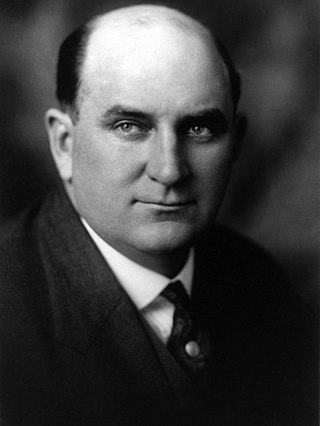
Lynn Joseph Frazier was an American educator and politician who served as the 12th governor of North Dakota from 1917 until being recalled in 1921 and later served as a U.S. Senator from North Dakota from 1923 to 1941. He was the first American governor ever successfully recalled from office. The only other American governor to ever be recalled is Gray Davis,who was recalled in 2003.
The Nonpartisan League (NPL) was a left-wing political party founded in 1915 in North Dakota by Arthur C. Townley,a former organizer for the Socialist Party of America. On behalf of small farmers and merchants,the Nonpartisan League advocated state control of mills,grain elevators,banks,and other farm-related industries in order to reduce the power of corporate and political interests from Minneapolis and Chicago.

William Frederick Lemke was an American politician who represented North Dakota in the United States House of Representatives as a member of the Republican Party. He was also the Union Party's presidential candidate in the 1936 presidential election.

The North Dakota Republican Party is the North Dakota affiliate of the United States Republican Party.

The 1921 North Dakota gubernatorial recall election was a recall election of North Dakota Governor Lynn Frazier in 1921. Frazier was the first U.S. governor ever successfully recalled from office;there would not be another successful recall of a governor until California Governor Gray Davis was recalled in 2003.

Arthur Charles Townley was an American political organizer best known as the founder of the National Non-Partisan League (NPL),a farmers' organization which had considerable political success in the states of North Dakota and Minnesota during the second half of the 1910s.

William "Wild Bill" Langer was an American lawyer and politician who served as the 17th governor of North Dakota from 1932 to 1934 and the 21st governor from 1937 to 1939. His governorship was demarcated by a scandal that forced him out of office and into multiple trials.

John N. Hagan was a North Dakota Republican/NPL politician who served as the North Dakota Commissioner of Agriculture and Labor from 1917 to 1921 and from 1937 to 1938. He is one of three politicians in the state ever to be recalled;he was recalled during his first time in the office along with fellow NPL politicians Governor of North Dakota Lynn J. Frazier and North Dakota Attorney General William Lemke in 1921.

Obert A. Olson was a North Dakota public servant and politician with the Republican Party. Olson served as a state legislator,State Treasurer (1919-1920),and mayor of Bismarck (1937-1938).

Carl R. Kositzky was a North Dakota public servant and politician with the Republican Party who served as the North Dakota State Auditor from 1917 to 1920.

The politics of North Dakota were shaped historically by early settlement by people from the Northern Tier,who carried their politics west ultimately from New England,upstate New York,and the Upper Midwest. The area and state also received numerous European immigrants and migrants,particularly during the era of opening up of former Native American lands for sale and settlement.

Sveinbjörn Johnson was an Icelandic-born American lawyer,politician and scholar.
Joseph A. Kitchen was a North Dakota state legislator and the state Commissioner of Agriculture and Labor from 1921 to 1932.

A general election was held in the U.S. state of North Dakota on November 4,2014. Five of North Dakota's executive officers were up for election as well as the state's at-large seat in the United States House of Representatives. Primary elections were held on June 10,2014.

North Dakota held two statewide elections in 2018:a primary election on Tuesday,June 12,and a general election on Tuesday,November 6. In addition,each township elected officers on Tuesday,March 20,and each school district held their elections on a date of their choosing between April 1 and June 30.
Thorstein Hartvig Haugen Thoresen was a Norwegian-American lawyer and politician in the state of North Dakota. He served as the 18th lieutenant governor of North Dakota from 1937 to 1939 under Governor William Langer.

Minnie Jean Nielson was an American educator and literacy activist from North Dakota. She served as the eleventh North Dakota Superintendent of Public Instruction from 1919 to 1926.

Neil Carnot Macdonald was an American educator from North Dakota. He served as the tenth North Dakota Superintendent of Public Instruction from 1917 to 1918.

O. E. Lofthus was a teacher,banker,and politician who served as the North Dakota state bank examiner from 1919 to 1921.

George A. Totten Sr. was an American minister,newspaper publisher,and politician. He served on the now-defunct North Dakota Board of Regents (1917-1919) and the North Dakota Board of Administration (1919-1921).
















